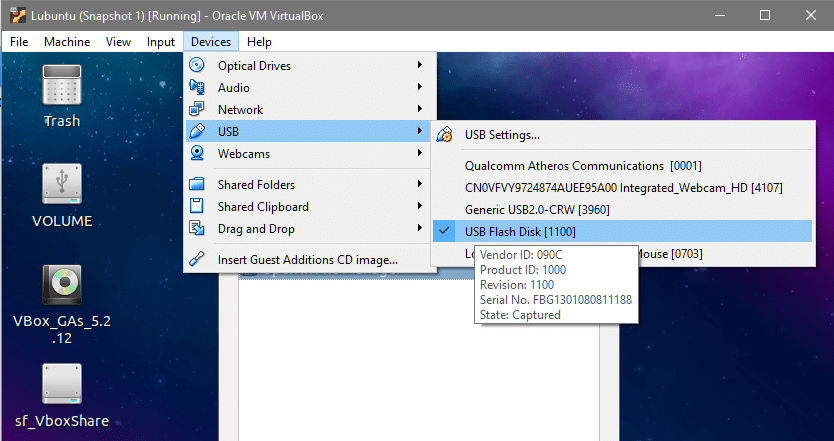

- HOW TO USE VIRTUALBOX EXTENSION PACK INSTALL
- HOW TO USE VIRTUALBOX EXTENSION PACK FULL
- HOW TO USE VIRTUALBOX EXTENSION PACK SOFTWARE
- HOW TO USE VIRTUALBOX EXTENSION PACK PASSWORD
- HOW TO USE VIRTUALBOX EXTENSION PACK PLUS
In either case, give VirtualBox the permission to install the necessary packages.
HOW TO USE VIRTUALBOX EXTENSION PACK PASSWORD
You will then be prompted for your root or sudo password (for Linux users) and Windows users will be greeted by a familiar UAC prompt. Click install and then Agree to the terms and services if you would like to use the extension pack. Since we obtained our extension pack from the official website, it is quite safe to install it.
HOW TO USE VIRTUALBOX EXTENSION PACK SOFTWARE
Upon selecting and clicking OK, you will be informed that some of the system level software can harm your computer if they are untrusted. Most likely, it is in your Downloads folder.
HOW TO USE VIRTUALBOX EXTENSION PACK PLUS
Use the icon on the right side which has a plus sign on it, to open File explorer and locate the Extension pack that we downloaded earlier, in your filesystem. In this Window, select the Extensions option from the left-side menu. Once the file is downloaded, open up your VirtualBox manager, from the top menu select File → Preferences (Top-left corner) and a new VirtualBox Preferences window will pop up.

vbox-extpack which is the same exact file for any host operating system be it Windows, Linux or macOS. The file is about 20 MB in size and has the extension. Click on “All supported platforms” to get this file.

To get your copy of the extension pack, visit the official VirtualBox site and scroll down to the Oracle section and download the extension pack for your running version of VirtualBox. A few extra functionalities include NVMe support, Remote Desktop and PXE boot for Intel chips.
HOW TO USE VIRTUALBOX EXTENSION PACK FULL
Which is why you need to install the VirtualBox extension pack and agree to a different license in order to use it.įunctionalities such as USB 2.0 and 3.0 support, full disk encryption for your virtual disk images and even physical disk passthrough are available within this pack. The latter is released under GPL version 2 which is doesn’t allow the former to come preinstalled alongside VirtualBox core package. If you now wish, you are able to install Kali Linux in a VirtualBox VM (on Kali Linux).A lot of features offered by Oracle (the company that owns VirtualBox) are offered under a separate license from that of the core VirtualBox software.

You can now find VirtualBox in the menu or start it via the command line. When prompted, read and accept the license. :~$ sudo apt install -y virtualbox virtualbox-ext-pack Now its time to install VirtualBox itself (along with its Extension Pack to expand VirtualBox’s advanced features). vboxdrv, vboxnetflt and vboxnetadp), we need to make sure they are kept up-to-date when Kali Linux’s kernel gets updated. :~$ sudo apt updateĪs VirtualBox has various kernel modules (e.g. At the time of writing, its “buster”: :~$ echo "deb bullseye contrib" | sudo tee /etc/apt//virtualbox.listĪs we have altered our network repository, we need to re-build the cache. One thing to bear in mind, Kali Linux is based on Debian, so we need to use Debian’s current stable version (even though Kali Linux is a rolling distribution). You may need to alter the example below if yours is different. We also will be making sure to state where the keyring is at so the files can be properly signed. We add this to a separate file, so it does not interfere with Kali Linux’s main repository. We then move onto adding VirtualBox’s repository. :~$ curl -fsSL |sudo gpg -dearmor -o /etc/apt//oracle_vbox.gpg :~$ curl -fsSL |sudo gpg -dearmor -o /etc/apt//oracle_vbox_2016.gpg The first thing we are going to do is import VirtualBox’s repository key. Preparationīefore trying to install VirtualBox, please make sure your version of Kali Linux is up-to-date, and if required, reboot the machine. Then there is also VMware Workstation & Fusion, which is a commercial software (there is VMware Player which is free but it is limited in features). There are a few other software such as QEMU, KVM/Xen with virt-manager. Another is when something is going right, take a snapshot. You can have your host machine “untouched”, and then only interact with the guest VMs. One of the being, able to run multiple Operating Systems (OSs) at the same time. However if you are wanting to install Kali Linux as a VM, you want our Kali Linux Guest VirtualBox guide. You can install VirtualBox on Kali Linux, allowing you to use virtual machines (VMs) inside of Kali Linux.


 0 kommentar(er)
0 kommentar(er)
